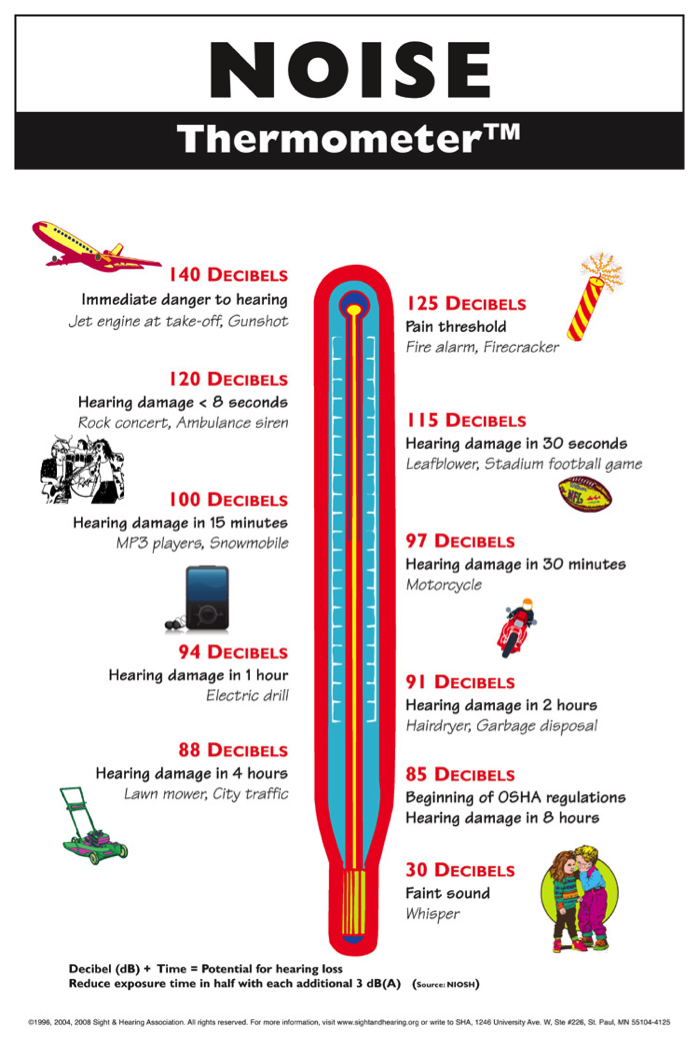Hearing Loss Prevention
Approximately 48 million Americans have hearing loss. One in three developed their loss as a result of exposure to noise.
Noise-induced hearing loss is caused by damage to the hair cells that are found in the cochlea. Hair cells are small sensory cells that convert the sounds we hear (sound energy) into electrical signals that travel to the brain. Once damaged, our hair cells cannot grow back, causing permanent hearing loss.
Harmful sounds are (1) too loud and last too long or (2) very loud and sudden. For example, exposure to a one-time intense “impulse” sound such as an explosion, or continuous exposure to loud sounds over an extended period of time, such as attending a concert or noisy sporting event, may cause irreversible damage. You may encounter harmful sounds at work, at home, or during recreational activities.
How loud is too loud?
The loudness of sound is measured in units called decibels (dB). Noise-induced hearing loss can be caused by prolonged exposure to any loud noise over 85 dB.
60 dB—Normal conversations or dishwashers
80 dB—Alarm clocks
85 dB—City traffic
90 dB—Hair dryers, blenders, and lawnmowers
100 dB—MP3 players at full volume
110 dB—Concerts, car racing, and sporting events
120 dB—Jet planes at take-off
130 dB—Ambulances and fire engine sirens
140 dB—Gunshots, fireworks

courtesy of the Better Hearing Institute
How do I prevent hearing loss?
You can protect your hearing by turning down the volume when listening to the radio, TV, MP3 players or anything through earbuds and headphones. When you’re exposed to sounds that exceed 85 dB for an extended time period, the best way to protect your hearing is by wearing hearing protection. Hearing protection decreases the intensity, or loudness, of noise and helps preserve your hearing. There are different types of hearing protection, such as foam earplugs, earmuffs and custom hearing protection devices. Contact your Henry Ford audiologist to order custom hearing protection devices and to learn about their costs.
Types of hearing protection available:
- Disposable plugs are placed inside the ear canal to block out noise. They are commonly made of expandable foam. One size fits most everyone. They roll up into a thin cylinder for insertion and once inside your ear canal, expand to form a good seal. Keep the plugs as clean as possible by inserting them with clean hands. Always inspect them before reinsertion. If they are damaged or dirty, throw them away.
- Sound isolating earphones with universal-fit ear tips. These earphones provide considerable sound isolation to most people, therefore the volume levels on music devices can be set lower. Noise cancelling headphones are also available; these do a great job of cancelling steady state noise such as that found on an airplane. These devices require little maintenance. The ear tips may be cleaned as needed; if they become brittle, simply replace.
- Reusable plugs are preformed to fit the ear. They are usually made of a flexible rubber or silicon. They may be flanged or cone-shaped and are often joined by a cord to prevent them from being lost. Reusable plugs can be worn safely for months, depending on the type. They should be replaced as soon as they become hard, torn or deformed.
- Earmuff stereo headphones. The soft plastic cushions, filled with foam or liquid, should form a good seal against noise. If you wear glasses with wide temples, you may want to choose another type of protector. If you're exposed to very loud noise, you can wear earmuffs and plugs together. Wipe the cushions clean with a damp rag when they become soiled. Check the cushions often, and replace them if they're stiff, worn, cut or torn. Do not modify your muffs in any way.
- Musician’s Earplugs are custom fit earmolds that fill the ear canal and come with removable filters designed for different levels of attenuation: 9 dB, 15 dB, or 25 dB. Musicians and music enthusiasts may prefer to use a type of earplug that is designed to match the ear’s natural response, making sound quieter, but not distorted. Filters in these musician’s plugs use a diaphragm that reduces noise levels equally across all frequencies.
.svg?iar=0&hash=F6049510E33E4E6D8196C26CCC0A64A4)

/hfh-logo-main--white.svg?iar=0&hash=ED491CBFADFB7670FAE94559C98D7798)